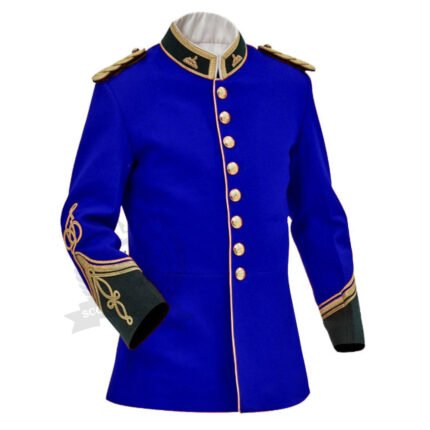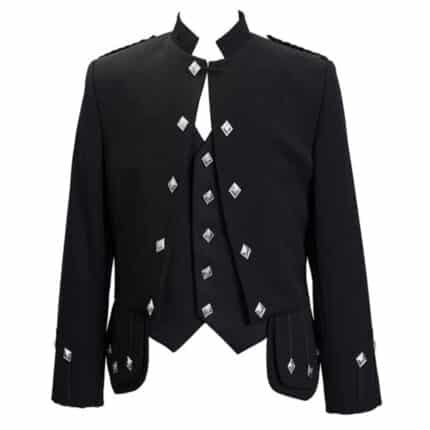What is a doublet in clothing?

Introduction
Hook: Exploring Renaissance Fashion
Step back into the opulent world of the Renaissance, where every garment was a testament to elegance and refinement. Picture the bustling streets of Florence or the grand halls of Tudor England, where fashion was not just a means of dressing but a form of artistic expression.
Definition of a Doublet:
At the heart of Renaissance men’s fashion lies the doublet, a quintessential garment that encapsulated the essence of the era’s sartorial splendor. The doublet clothing, originating in the 14th century and reaching its pinnacle during the Renaissance, was more than just a piece of clothing; it was a symbol of status, taste, and craftsmanship.
Importance of Understanding Historical Garments
Delving into the intricacies of historical garments like the doublet is not merely an exercise in nostalgia; it is a journey that enriches our understanding of fashion evolution. By studying the construction, materials, and cultural significance of garments from bygone eras, we gain valuable insights into the roots of contemporary clothing trends and design aesthetics.
Understanding the nuances of historical garments allows us to appreciate the craftsmanship and artistry of the past while also recognizing their enduring influence on modern fashion. From the tailored silhouette of a doublet to the intricate embellishments adorning its surface, each element tells a story of craftsmanship, cultural values, and societal norms of its time.
Historical Context
Origins: Tracing back to 14th century Europe, particularly England.
The roots of the doublet, a quintessential garment of Renaissance fashion, can be traced back to 14th-century Europe, with England serving as a focal point for its emergence. Initially, the doublet was a practical garment worn by men as an underlayer beneath outer garments such as tunics and robes. Its early iterations were simple and utilitarian, primarily serving functional purposes such as providing additional warmth and support. Crafted from sturdy fabrics like wool or linen, these early doublets lacked the ornate embellishments and tailored fit that would later characterize the garment during the Renaissance era.
-
Regulation Doublet
Original price was: $219.00.$179.00Current price is: $179.00. -
Royal Blue Zulu War Jacket
Original price was: $249.00.$199.00Current price is: $199.00. -
Scottish Doublet Jacket
Original price was: $219.00.$199.00Current price is: $199.00. -
Sheriffmuir And Vest
Original price was: $219.00.$199.00Current price is: $199.00. -
Sheriffmuir Grey Wool Pride Jacket
Original price was: $219.00.$199.00Current price is: $199.00. -
Sheriffmuir Jacket With Vest
Original price was: $219.00.$179.00Current price is: $179.00. -
Short Military Parade Gothic Jacket
Original price was: $249.00.$189.00Current price is: $189.00. -
Silver Hussar Parade Steampunk Gothic Jacket
Original price was: $249.00.$169.00Current price is: $169.00. -
Violet Zulu War Jacket
Original price was: $249.00.$199.00Current price is: $199.00.
Evolution: How doublets evolved from padded garments to fitted jackets.
Over time, the doublet underwent a remarkable evolution, transitioning from its humble beginnings as a padded undergarment to a more refined and fitted outer garment. This transformation was driven by advancements in tailoring techniques and changes in fashion aesthetics. By the late 15th and early 16th centuries, doublets had shed their bulky padding in favor of a sleeker silhouette that accentuated the wearer’s physique. Tailors began employing techniques such as slashing and panning to create decorative patterns and seams, further enhancing the garment’s visual appeal.
The transition from padded doublets to fitted jackets also reflected broader shifts in societal norms and ideals of masculinity. As Renaissance ideals of elegance and refinement took hold, men sought clothing that not only provided practicality but also showcased their social status and fashion sensibilities. The fitted doublet emerged as a sartorial symbol of sophistication and refinement, favored by nobles and courtiers eager to display their wealth and cultural refinement.
Cultural Significance: Doublets as status symbols and markers of social class.
Within the context of Renaissance society, doublets held significant cultural and social significance, serving as potent symbols of status and class distinction. The elaborately embellished doublets worn by aristocrats and royalty were not merely garments but expressions of power, privilege, and prestige. The materials used in their construction, such as sumptuous silks, velvets, and brocades, were often prohibitively expensive, and accessible only to the wealthiest members of society.
Moreover, the intricacy of craftsmanship and the attention to detail lavished upon these garments were indicative of the wearer’s refined taste and cultural refinement. Doublets became vehicles for conveying one’s social standing and aspirations, with elaborate embroideries, intricate patterns, and opulent embellishments serving as visual markers of wealth and nobility.
Construction and Design
Materials Used
During the Renaissance period, the materials used in the construction of doublets varied significantly depending on the wearer’s social standing and occasion. For the elite class, silk and velvet were the fabrics of choice, prized for their luxurious feel and opulent appearance. These materials not only conveyed wealth but also reflected the wearer’s status and influence within society. Conversely, commoners often wore doublets made from more affordable fabrics such as wool and linen. While not as extravagant as their silk counterparts, these materials were durable and practical, making them suitable for everyday wear.
Tailoring Techniques
One of the most fascinating aspects of doublet construction lies in the intricate tailoring techniques employed to create these garments. Tailors of the Renaissance era were skilled artisans who utilized a variety of methods to achieve the desired fit and aesthetic. Slashing, a technique where cuts were made in the fabric and then adorned with contrasting material, was a popular decorative element that added texture and visual interest to doublets. Panning involved the use of strips of fabric to create decorative panels or stripes, further enhancing the garment’s appearance. Additionally, padding was often used to add structure and shape to the doublet, creating a silhouette that was both elegant and flattering.
Ornamentation
Embellishments played a crucial role in elevating the aesthetic appeal of doublets, serving as a reflection of the wearer’s taste and wealth. Embroidery was a favored decorative technique, with intricate designs featuring motifs such as floral patterns, animals, and heraldic symbols. Beading was another common embellishment, adding a touch of sparkle and glamour to the garment. Precious gems, pearls, and metallic threads were often used to create elaborate embellishments that showcased the wearer’s affluence and status. Overall, ornamentation served not only as a means of adornment but also as a form of self-expression and cultural identity.
Functionality and Purpose
Practicality: An Understated Elegance
Despite their opulent appearance, doublets were far from mere displays of wealth and status. Their practicality was often overshadowed by their sumptuous aesthetics. Crafted from a variety of durable fabrics, including wool, linen, and silk, doublets offered wearers both warmth and protection against the elements. The snug fit of these garments not only provided insulation but also allowed for ease of movement, crucial for individuals engaged in various activities, be it the pursuits of courtly life or the rigors of everyday tasks. This fusion of functionality with elegance epitomized the Renaissance approach to fashion, where garments were expected to serve both practical and aesthetic purposes.
Social Symbolism: A Language of Cloth and Thread
Within the intricate tapestry of Renaissance society, doublets served as powerful symbols of social status, occupation, and even political allegiance. The quality of materials, the richness of embellishments, and the precision of tailoring all communicated volumes about the wearer’s place in the social hierarchy. For the elite, doublets crafted from sumptuous fabrics such as velvet or brocade, adorned with intricate embroidery and precious jewels, were not just articles of clothing but declarations of wealth and influence. Conversely, simpler, more utilitarian doublets worn by commoners reflected their modest means and societal standing. Furthermore, the colors, patterns, and insignias embellishing these garments often conveyed subtle messages of allegiance to certain factions or families, making doublets not only markers of personal status but also instruments of political and social expression.
Versatility: From Courtly Elegance to Everyday
Wear One of the most remarkable features of doublets was their remarkable versatility. While they were undoubtedly favored attire for the grandeur of courtly events and formal occasions, they were equally well-suited to the demands of everyday life. The adaptability of doublets lay in their ability to be styled and accessorized according to the occasion, effortlessly transitioning from the refined opulence of court attire to the practicality of everyday wear. Pairing a doublet with breeches and hose created a formal ensemble suitable for courtly gatherings and festivities, while pairing it with more relaxed garments like a simple shirt and trousers rendered it suitable for more casual settings. This versatility not only attests to the ingenuity of Renaissance fashion but also underscores the practical sensibilities that underpinned even the most extravagant of garments.
Legacy and Influence
Fashion Legacy
The legacy of doublets in contemporary menswear is profound, serving as a testament to the enduring influence of historical fashion. While the Renaissance era might seem distant, its sartorial elements continue to resonate in modern clothing. Designers draw inspiration from the structure, silhouette, and detailing of doublets, infusing them into their collections with a modern twist. The timeless elegance and sophistication associated with doublets persist in the fashion landscape, captivating designers and fashion enthusiasts alike.
Adaptations
Modern designers exhibit a remarkable penchant for reinterpreting doublet elements in their collections, seamlessly blending historical aesthetics with contemporary sensibilities. From high fashion runways to ready-to-wear lines, doublet-inspired jackets, vests, and shirts grace the modern wardrobe. These adaptations often feature sleeker silhouettes, innovative fabrics, and updated embellishments, offering a fresh take on a classic garment. By marrying tradition with innovation, designers pay homage to the rich heritage of doublets while ensuring their relevance in today’s fashion scene.
Cultural Impact
Beyond the realm of fashion, doublets exert a notable cultural impact, transcending historical boundaries to resonate with diverse audiences. In popular culture, doublets frequently make appearances in historical dramas, films, and television series, where they serve as visual markers of bygone eras. Moreover, the resurgence of interest in historical reenactments and cosplay communities has propelled doublets into the spotlight, with enthusiasts meticulously recreating period-accurate attire. Through these cultural manifestations, doublets continue to captivate imaginations and evoke a sense of nostalgia for times long past.










